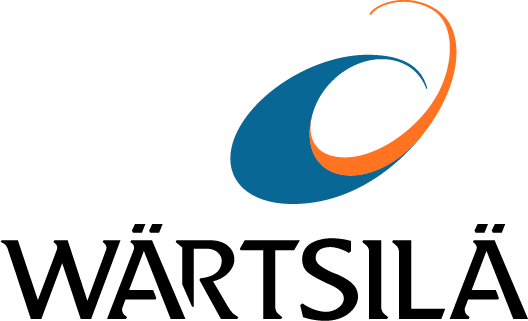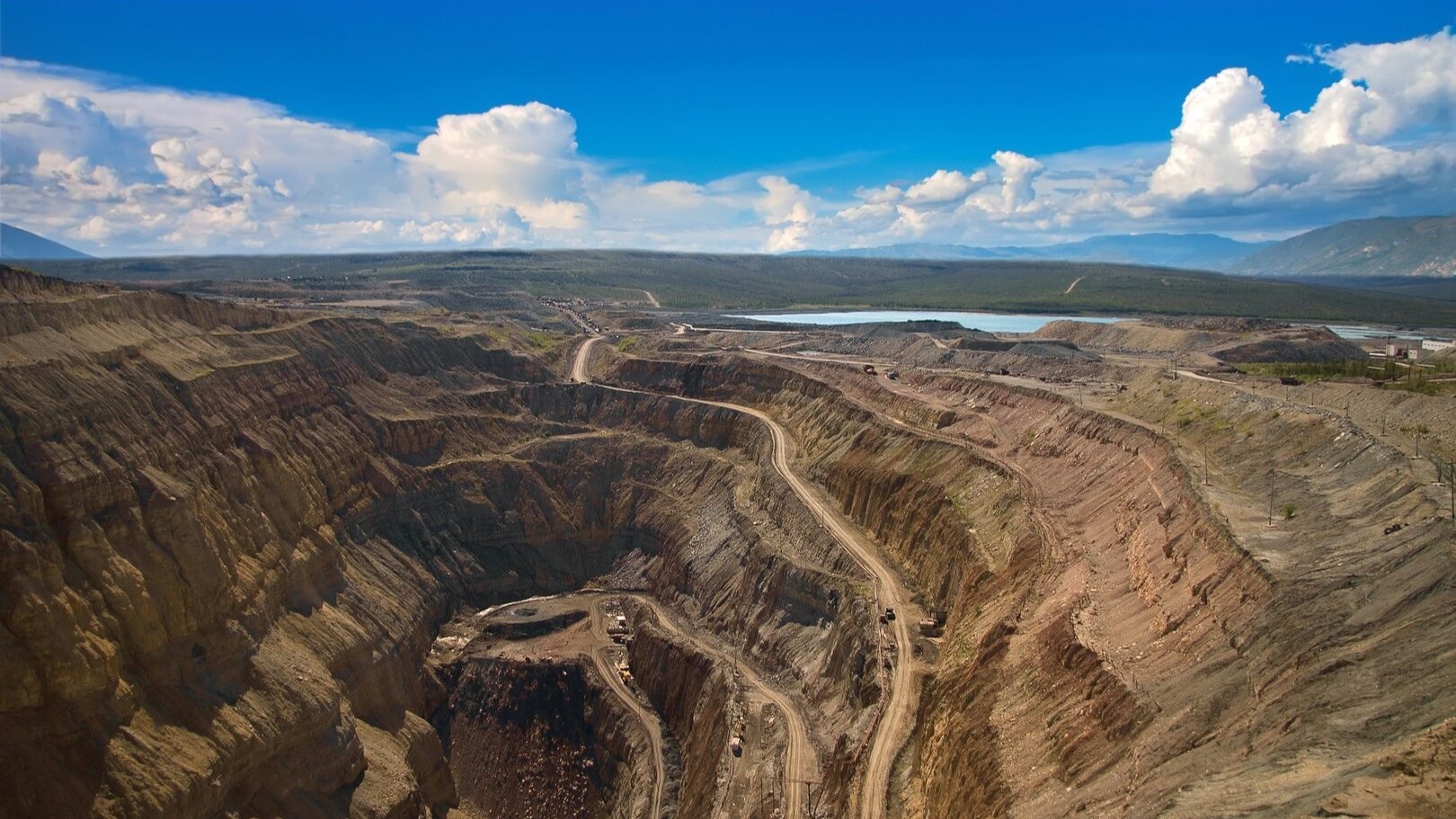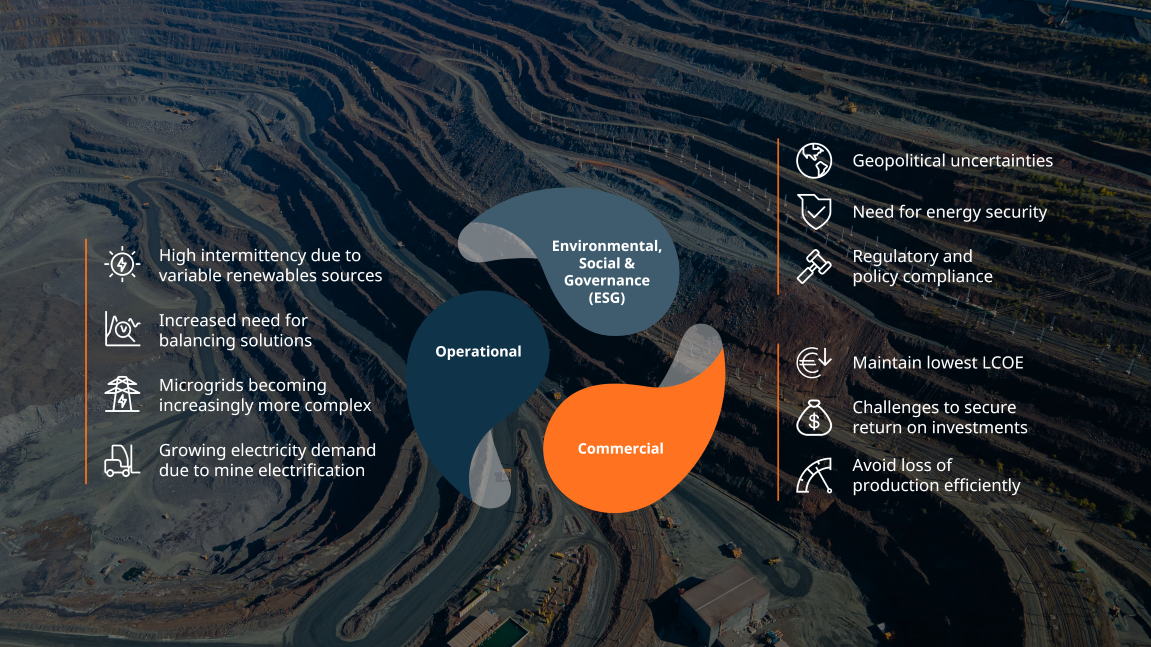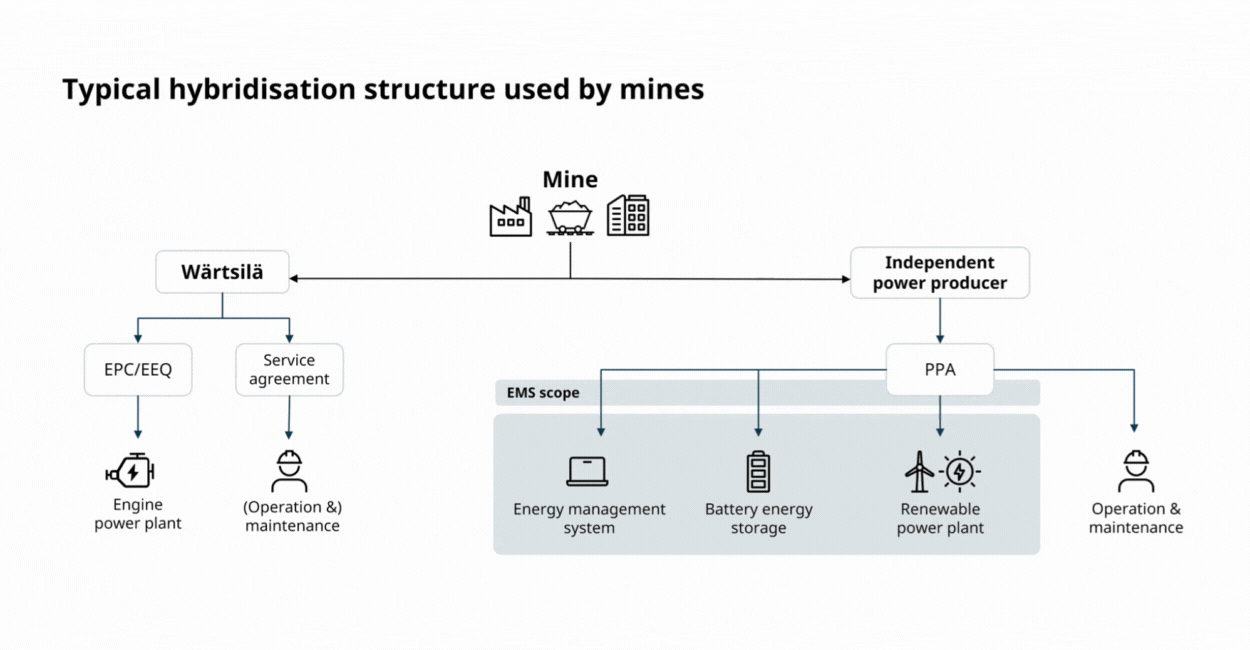

As mines work their way towards decarbonised operations, they might face a multitude of complexities, requiring operators and their partners to acquire a holistic approach to decarbonisation.
For mines to fully decarbonise, various environmental, technical and commercial aspects will need to be considered. Environmental, social and governance considerations include geopolitical uncertainties, the need for energy security, and compliance with regulations and policies. Financial and commercial challenges involve maintaining the lowest levelised cost of electricity (LCOE), securing returns on investments, and avoiding losses in production efficiency. On the technical side, the high intermittency of renewable energy sources increases the need for balancing solutions, such as grid balancing engines. Additionally, the growing complexity of microgrids and rising electricity demand due to mine electrification add further challenges. Microgrids are designed to add protection to an area that is reliant on a constant electrical supply, such as mining operations.

In this article, we will address the technical and commercial challenges that mines may encounter during the decarbonisation journey. Mines microgrid’s are changing due to the energy transition, with different power generation assets being introduced (energy storage, solar and / or wind) alongside balancing power generation – a process known as hybridisation. We will do this by exploring an energy management system as a solution to hybridisation challenges and present a new commercial model for hybrid mines.
Addressing hybridisation challenges with energy management system
In this section we will examine how hybridisation challenges can be taken care of with an energy management system. As the proportion of the power generation coming from variable and intermittent sources, such as solar and wind, is increasing, operating and optimising the power system becomes increasingly complex. Instead of simply dispatching balancing power units to meet the load of the mines, operators need to consider a multitude of variables, such as: what will be the renewable yield in the coming minutes and hours? How much spinning reserves will be needed to manage system stability? Which assets will provide these most efficiently? What is the battery’s state of charge, and how should it be dispatched? Which are my most efficient assets to run to meet loads and system requirements?
If these complexities are not addressed, significant amounts of renewable energy may be curtailed to maintain system stability, resulting in poor return on investment for renewable projects. Adding renewables may not result in decreased fuel consumption if the different assets in the power system aren't used optimally. This may result in suboptimal loading of engines and therefore high costs and emissions. In worst case scenario, the system may fail to meet requirements, causing reliability issues and potential blackouts, which directly impacts mine operations and revenue.
Wärtsilä’s Digital Energy Platform, GEMS, addresses these technical complexities associated with system hybridisation. GEMS is a technology-agnostic controls and optimisation software that monitors, controls and optimises energy assets and system performance to reduce costs while meeting the system constraints. The platform utilises sophisticated renewable and load forecasts in its optimisation and supports a wide variety of power generation assets to achieve optimal system performance.
The GEMS software integrates and controls individual resources and entire fleets comprising energy storage, renewables and balancing power generation. Using machine learning and historical and real-time data analytics to optimise the energy mix, GEMS enables customers to remotely monitor, operate, identify and diagnose equipment with unrivalled safety, reliability, and flexibility. GEMS can also act as a microgrid controller, offering secondary and tertiary control to optimise power generation further.
Unlocking the full potential of microgrids
The typical structure mines use in hybridisation projects does not enable taking advantage of sophisticated systems like GEMS, and traditional procurement practices do not provide a commercial framework to incentivise system-level optimisation. The following is a typical example of how a mine may approach microgrid hybridisation and what kind of commercial challenges this approach entails:
- The customer has an engine power plant sold with typical performance guarantees. At the same time, a service agreement has been signed with further guarantees on the lifecycle performance of the assets.
- In some years, the customer wants to take advantage of cost-efficient solar power and signs a power purchase agreement with an independent power producer (IPP).
- Further down the road, the customer is concerned about the fluctuation of the solar power generation and requires the IPP to also install energy storage for smoothing.
- The IPP owns, operates and maintains the solar power and the battery and usually an energy management system, which mainly dispatches the battery against the solar power.

On the other side, the IPP purchases the assets and potential services from third parties and has typical guarantees for each asset, such as performance ratios or power and capacity guarantees. These guarantees are passed through to the customer under the power purchase agreement.
Here, each party is only incentivised to reach the guaranteed values of the individual assets that they are liable for and try to optimise what is within their scope. No one has the incentive or the capability to optimise the whole system. All this results in renewable energy curtailment, suboptimal utilisation of the energy storage system, unnecessarily high fuel consumption and running hours on the engines, potential reliability issues, and, in the end, an overall higher levelised cost of electricity.
To tackle the challenge of individual guarantees, Wärtsilä has created a commercial concept, where the energy management system integrates all the power generation assets. The engine power plant and the service agreement are there to provide the reliability and act as the backbone of the system, while the IPP who owns the solar power and energy storage system oversees the operation and maintenance. The GEMS energy management system can control and optimise not only the renewables and the energy storage system, but also the engine power plant. Energy storage is now not only supporting renewables but also creating additional value by replacing balancing power spinning reserves. Furthermore, GEMS forecasting capabilities are improving dispatch decisions for both the engine power plant and the energy storage syste.

The guarantees on the individual assets are still in place, but there is an additional obligation for the energy management system to dispatch all the assets and optimise the entire system. It is now the shared interest of the customer and Wärtsilä to ensure the entire microgrid is running efficiently and reliably. This will result in a lower levelised cost of electricity, optimised spinning reserves, and minimised curtailment. Instead of providing individual guarantees, this would be an outcome-based commercial model that covers all the assets in the microgrid. Wärtsilä is measuring the overall optimisation of the grid with a revenue-based contract on the overall grid performance.
In conclusion: By embracing a holistic approach mining operations can master the complexities of hybridisation
The transition to 100% renewable energy in mining operations presents both significant challenges and promising solutions. By adopting a holistic approach that integrates advanced energy management systems like Wärtsilä's GEMS, mines can effectively navigate the complexities of hybridisation, optimise energy usage, and enhance system reliability. Our decarbonisation services use outcome-based agreements, so our gain is based upon our customers’ goals, like savings, emissions and reliability. The shift towards an outcome-based commercial model fosters collaboration among stakeholders, ensuring that all components of the energy mix work together efficiently. This not only reduces the levelised cost of electricity, but also maximises the potential of renewable resources, paving the way for a sustainable and resilient future in mining operations.
Wärtsilä has all the capabilities needed to integrate and optimise hybrid microgrids. Our combined software, hardware and agreement solutions, paired with our knowledge and expertise, empower microgrid operators to reduce CO2 emissions and cost savings, without compromising reliability.
Related solutions
https://www.wartsila.com/energy/services/lifecycle-solutions/decarbonisation-services

